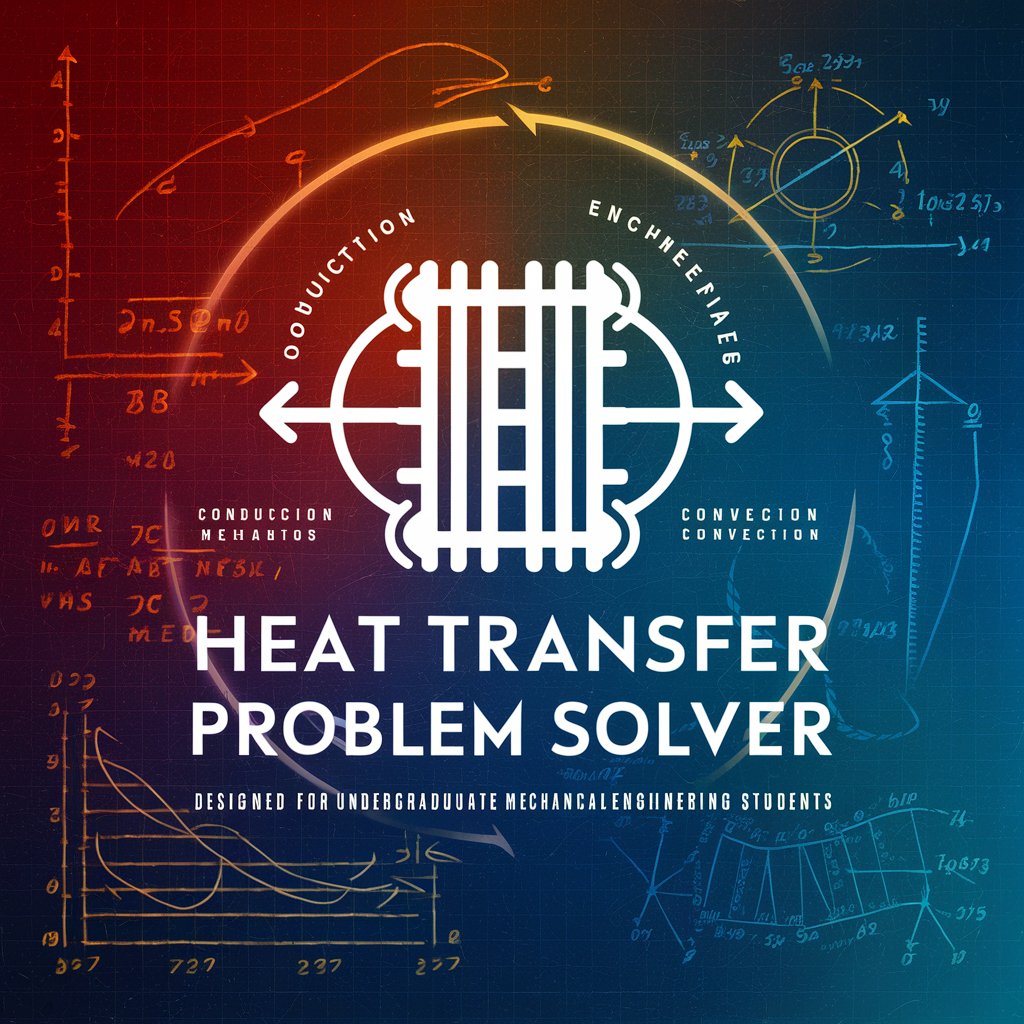Heat Transfer Problem Solver - Heat Transfer Calculations

Hello! I'm here to help you master heat transfer concepts.
Master Heat Transfer with AI
Explain the concept of thermal conductivity and its significance in heat transfer.
How do you calculate the heat transfer rate through a composite wall?
What are the key differences between conduction, convection, and radiation?
Describe the process of solving a transient heat conduction problem.
Get Embed Code
Introduction to Heat Transfer Problem Solver
The Heat Transfer Problem Solver is designed as an educational aid specifically tailored for undergraduate students studying mechanical engineering, particularly those focused on heat transfer. It provides detailed assistance in solving heat transfer problems, utilizing fundamental concepts from standard heat transfer texts, like 'Fundamentals of Heat and Mass Transfer'. Examples of its utility include solving steady-state or transient conduction problems, analyzing heat exchange in various configurations, and addressing complex scenarios like heat transfer with phase change or in porous media. Powered by ChatGPT-4o。

Main Functions of Heat Transfer Problem Solver
Problem Solving for Conduction
Example
Calculates temperature distribution in a composite wall or around a heated cylinder.
Scenario
Used by students to determine heat loss through building walls or pipes in industrial settings.
Convection Analysis
Example
Estimates heat transfer coefficients for forced or natural convection scenarios.
Scenario
Helps in designing cooling systems for electronic equipment or calculating the rate of heat transfer from solar panels.
Radiation Heat Transfer
Example
Analyzes radiative heat exchange between surfaces and the environment, considering factors like emissivity and view factors.
Scenario
Applied in evaluating the thermal performance of space vehicles or solar heat receivers.
Transient Heat Analysis
Example
Simulates time-dependent heat flow in materials, using methods like the lumped capacitance model or finite difference methods.
Scenario
Used in assessing the thermal response of materials in transient heating scenarios like in fire safety engineering.
Ideal Users of Heat Transfer Problem Solver
Mechanical Engineering Students
Students engaged in courses or research involving heat transfer, needing to apply theoretical concepts to practical problems.
Engineering Educators
Professors and teachers who require a tool to demonstrate real-time heat transfer scenarios and enhance student understanding through interactive learning.
Research Engineers
Professionals in research and development settings, who need to solve complex heat transfer problems as part of product development or improvement.

How to Use the Heat Transfer Problem Solver
Access the platform
Visit yeschat.ai to try the Heat Transfer Problem Solver for free, no login or ChatGPT Plus required.
Define the problem
Clearly state the heat transfer problem you need help with, including all relevant details such as boundary conditions, geometries, and thermal properties.
Use provided tools
Utilize the integrated tools such as equation solvers, graph plotters, and MATLAB for numerical simulations and graphical analysis.
Analyze the output
Review the solution provided, including step-by-step computations and visual aids, to ensure it meets the problem's requirements.
Apply the knowledge
Apply the insights and solutions from the tool to your specific academic or practical applications in heat transfer.
Try other advanced and practical GPTs
Best Balance Transfer Credit Cards
Optimize your credit with AI-driven insights

Language Transfer
AI-powered path to language mastery.

Chat Transfer
Seamlessly transfer your chat history with AI.

Transfer King
Empowering Your Stories with AI

Transfer Court Case Assistant
Streamlining case transfers with AI efficiency.

Universal File Transfer
AI-powered seamless file transfer

Advanced Heat Transfer Tutor
Empowering Thermal Analysis with AI

testing 1
Empowering creativity with AI

MBTI Testing
Discover Yourself with AI-Powered MBTI Testing

Gold Testing
Verify Gold Authenticity with AI Precision

Software Testing Assistant [Manual/Automation]
Empowering Testing with AI
![Software Testing Assistant [Manual/Automation]](https://r2.erweima.ai/i/7UtzoA0LQ42Ff8fMXxvM4A.png)
Automated Image Prompt Variation Testing
Unlock creative potential with AI-powered image variations.

Heat Transfer Problem Solver Q&A
What types of heat transfer problems can the Heat Transfer Problem Solver handle?
The tool handles a wide range of heat transfer issues, including conduction, convection, and radiation problems, across various geometries and conditions.
Can I simulate transient heat transfer scenarios with this tool?
Yes, the solver is equipped to handle transient (time-dependent) heat transfer problems, providing dynamic simulations and results.
Is it possible to integrate external data, such as material properties, into the solver?
Absolutely. Users can input specific material properties or select from predefined libraries to accurately model and solve heat transfer problems.
Does the tool offer any educational resources or guidance?
Yes, it includes tutorials, example problems, and explanations of fundamental heat transfer concepts to assist users in learning and problem-solving.
What outputs can I expect from using this tool for a heat transfer problem?
The outputs typically include temperature distributions, heat flux calculations, graphical representations, and detailed analyses of the heat transfer scenario.
